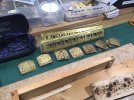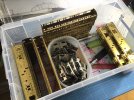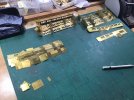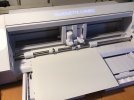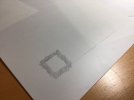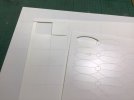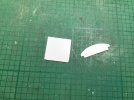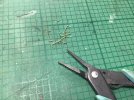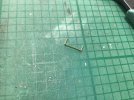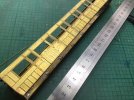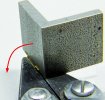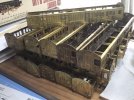On to bodywork
Heather Kay
Western Thunderer
With most of the underframe work complete, and still feeling a distraction from detailing the bogies is worth the effort, I turn to bodywork assembly.
As you may recall, I had assembled sides and ends some time ago. Theoretically it would be possible to join corners with only the aid of a square or three. This may be okay for a couple of bodies, but I’ve got 16 of the blighters to blunder through. Some further help in the form of a basic jig seemed sensible.
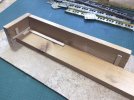
I spent far longer thinking about a jig than it took me to cast around for scraps of hardboard and timber, plug in the hot glue gun and just build it! I think you should be able to work out how it operates. An end can be wedged in place, with the corresponding side likewise. Adjustment should be minimal, with just a smidge of wiggle room, and the parts held enough that a couple of quick dabs of solder can be applied to join things together.
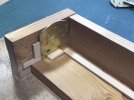
Here’s an end. Of course, all the detail is in place on the ends. I don’t want to damage any of that, so the strips of wood at the bottom allow for the depth of the end steps and the turnunder. I have since modified the nearer upright to allow for sliding the second side in place. You’ll see what I mean in a bit.
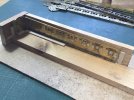
Add a side, tweak and adjust things along the joint by Eyeball, Human, Mark One - the end goes inside the side - drop of flux and in and out with the iron. I’ve taken to tack soldering. There doesn’t seem to be a need to run a seam, and tacking avoids the danger of overheating the relatively thin brass.
What I found, with the first attempt, was the end steps still got damaged. This was mainly during the extraction process, because the fit is meant to be tight. To solve this, and to check I got the turnunder curve correct at the much earlier stage, I reinforce the steps from inside. The resulting blobs are not pretty, but they’re not going to be seen. I also find I need to deal with the occasional loose lamp bracket, which is annoying but unavoidable. One's soldering isn’t always as good as one would hope.
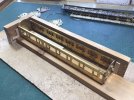
After joining an end and a side, I extract them from the jig and check for alignment. Sometimes, the end isn’t square - yes, even with my fancy-pants jig - so I lay the side flat on the bench and slap an engineer's square against the end. Some careful bending usually solves the problem. Sometimes, the end hasn’t seated neatly aligned with the side, so a bit of gentle persuasion against a flat surface and the application of the iron lets things click into place.
My original scheme was to join a pair of ends-and-sides on the bench. I realised the jig would make this easier, with one sub-assembly wedged in place and the other offered up. It takes a bit of a fiddle sometimes, but It does work. There’s no point that I can see to adding any more woodwork to aid the process.
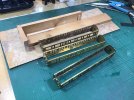
And after a bit of obligatory cursing and singed fingers, three composite bodies are made. They’ve just had a bath to rinse flux off. One final check, once both halves are joined, is using the square to check the corners are within a gnat's semi-quaver of 90°.
Now I know the jig works well enough, I can plough on with the other bodies. I think I’ll need to sort out storage again. In flat pack form storage was manageable. Now I’ve got 3D bodies to stack up.
Anyway, I’ve had enough for today. More construction next week.
As you may recall, I had assembled sides and ends some time ago. Theoretically it would be possible to join corners with only the aid of a square or three. This may be okay for a couple of bodies, but I’ve got 16 of the blighters to blunder through. Some further help in the form of a basic jig seemed sensible.

I spent far longer thinking about a jig than it took me to cast around for scraps of hardboard and timber, plug in the hot glue gun and just build it! I think you should be able to work out how it operates. An end can be wedged in place, with the corresponding side likewise. Adjustment should be minimal, with just a smidge of wiggle room, and the parts held enough that a couple of quick dabs of solder can be applied to join things together.

Here’s an end. Of course, all the detail is in place on the ends. I don’t want to damage any of that, so the strips of wood at the bottom allow for the depth of the end steps and the turnunder. I have since modified the nearer upright to allow for sliding the second side in place. You’ll see what I mean in a bit.

Add a side, tweak and adjust things along the joint by Eyeball, Human, Mark One - the end goes inside the side - drop of flux and in and out with the iron. I’ve taken to tack soldering. There doesn’t seem to be a need to run a seam, and tacking avoids the danger of overheating the relatively thin brass.
What I found, with the first attempt, was the end steps still got damaged. This was mainly during the extraction process, because the fit is meant to be tight. To solve this, and to check I got the turnunder curve correct at the much earlier stage, I reinforce the steps from inside. The resulting blobs are not pretty, but they’re not going to be seen. I also find I need to deal with the occasional loose lamp bracket, which is annoying but unavoidable. One's soldering isn’t always as good as one would hope.

After joining an end and a side, I extract them from the jig and check for alignment. Sometimes, the end isn’t square - yes, even with my fancy-pants jig - so I lay the side flat on the bench and slap an engineer's square against the end. Some careful bending usually solves the problem. Sometimes, the end hasn’t seated neatly aligned with the side, so a bit of gentle persuasion against a flat surface and the application of the iron lets things click into place.
My original scheme was to join a pair of ends-and-sides on the bench. I realised the jig would make this easier, with one sub-assembly wedged in place and the other offered up. It takes a bit of a fiddle sometimes, but It does work. There’s no point that I can see to adding any more woodwork to aid the process.

And after a bit of obligatory cursing and singed fingers, three composite bodies are made. They’ve just had a bath to rinse flux off. One final check, once both halves are joined, is using the square to check the corners are within a gnat's semi-quaver of 90°.
Now I know the jig works well enough, I can plough on with the other bodies. I think I’ll need to sort out storage again. In flat pack form storage was manageable. Now I’ve got 3D bodies to stack up.
Anyway, I’ve had enough for today. More construction next week.


